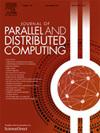CAMINOS互连网络模拟器
IF 3.4
3区 计算机科学
Q1 COMPUTER SCIENCE, THEORY & METHODS
引用次数: 0
摘要
本文提出了一种新的互连网络模拟器CAMINOS,主要关注路由器微架构。它是用Rust开发的,Rust是一种新颖的编程语言,语法类似于C/ c++,并且具有强大的内存保护。CAMINOS的架构强调组件的组合。这允许在不修改源代码的情况下在配置文件中定义新的设计,从而大大减少了工作量和时间。除了模拟功能外,CAMINOS还协助管理作为实验的模拟集合。这包括与SLURM的集成,以支持执行批量模拟和生成带有结果和诊断的pdf。我们证明CAMINOS很好地利用了计算资源。它的内存使用主要由运行中的消息控制,显示出内存使用的低开销。我们证明CAMINOS可以有效地利用CPU时间,因为很少争用的场景执行得更快。本文章由计算机程序翻译,如有差异,请以英文原文为准。
The CAMINOS interconnection networks simulator
This work presents CAMINOS, a new interconnection network simulator focusing on router microarchitecture. It was developed in Rust, a novel programming language with a syntax similar to C/C++ and strong memory protection.
The architecture of CAMINOS emphasizes the composition of components. This allows new designs to be defined in a configuration file without modifying source code, greatly reducing effort and time.
In addition to simulation functionality, CAMINOS assists in managing a collection of simulations as an experiment. This includes integration with SLURM to support executing batches of simulations and generating PDFs with results and diagnostics.
We show that CAMINOS makes good use of computing resources. Its memory usage is dominated by in-flight messages, showing low overhead in memory usage. We attest that CAMINOS can effectively use CPU time, as scenarios with little contention execute faster.
求助全文
通过发布文献求助,成功后即可免费获取论文全文。
去求助
来源期刊

Journal of Parallel and Distributed Computing
工程技术-计算机:理论方法
CiteScore
10.30
自引率
2.60%
发文量
172
审稿时长
12 months
期刊介绍:
This international journal is directed to researchers, engineers, educators, managers, programmers, and users of computers who have particular interests in parallel processing and/or distributed computing.
The Journal of Parallel and Distributed Computing publishes original research papers and timely review articles on the theory, design, evaluation, and use of parallel and/or distributed computing systems. The journal also features special issues on these topics; again covering the full range from the design to the use of our targeted systems.
 求助内容:
求助内容: 应助结果提醒方式:
应助结果提醒方式:


